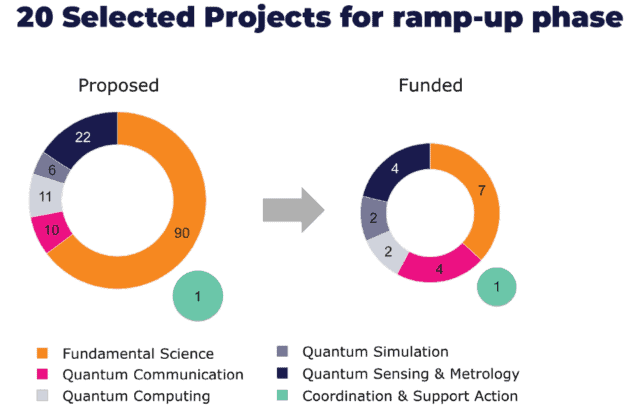Beneath the glamour, tough questions at the launch of Europe’s Quantum Flagship
05 Nov 2018 Margaret Harris
Last week’s launch of the €1bn European Quantum Flagship took place in glamorous surroundings amid a palpable buzz of excitement. But neither participants’ enthusiasm nor the elegance of the Zeremoniensaal in Vienna’s Hofburg palace could paper over disagreements about the flagship’s scope and purpose. The arguments centred around two questions: how much is a billion euros, and what exactly is “basic science”?
Quantum innovations are cheap compared to discoveries in experimental particle physics or astronomy. The most expensive pieces of lab equipment rarely stretch beyond the low five figures (in euros, pounds or dollars), and most of the work is done by modestly-paid PhD students and postdocs (I did my own PhD in a related field). Hence, by the standards of the quantum-science community, both the flagship’s billion-euro headline figure and its €132m initial phase are significant investments.
By other measures, though, the European Commission’s €500m bet (the rest of the money will come from individual member countries) looks less earth-shattering. A bill currently moving through the US Congress would earmark $1.2bn for a ten-year initiative in quantum computing and communications. In September, the German government announced its own five-year, €650m quantum-technologies programme. The UK government’s 2018 budgetincludes £235m for the country’s National Quantum Technologies Programme, which received its first £270m tranche in 2013. And among the scientists in the Zeremoniensaal, there was a widespread (if not always well-substantiated) consensus that however much Europe is spending on quantum science, China must be spending more.
With any finite pot of money, debates about how to spend it are inevitable. At the launch of Europe’s Quantum Flagship, the major flashpoint was an apparent gap between what the academic quantum-science community wants to do, and what the flagship intends to support. Despite the flagship’s emphasis on fostering industrial applications, fully 90 of 140 proposals submitted were in basic science. Of these, only seven received the go-ahead – a far lower percentage than in other categories. A comparison of the number of submitted (left) and funded (right) proposals in each category of the European Quantum Flagship.
A comparison of the number of submitted (left) and funded (right) proposals in each category of the European Quantum Flagship.
 A comparison of the number of submitted (left) and funded (right) proposals in each category of the European Quantum Flagship.
A comparison of the number of submitted (left) and funded (right) proposals in each category of the European Quantum Flagship.
The result was a storm of criticism. During an open-floor debate, Enrique Solano of the University of the Basque Country in Spain undoubtedly spoke for many when he asked, “Is the role of basic science through the flagship to disappear?” By the event’s second day, Nicolas Gisin, a physicist who pioneered quantum-key distribution (QKD) in his lab at the University of Geneva, Switzerland, was semi-seriously suggesting that “the only way to save basic science is to remove it from the flagship” entirely.
In the event’s satellite sessions, however, it emerged that some industry scientists also have concerns – in the opposite direction. Diego Lopez, a senior technology expert at the Spanish telecoms firm Telefonica, worried that the flagship will not help businesses make the transition from classical to quantum communications networks. Stephan Ritter, an applications specialist at the Germany-based laser firm Toptica Photonics, wondered aloud about how to convince people that there was a market for all these exciting new quantum technologies. And Grégoire Ribordy, CEO of the QKD firm ID Quantique (which spun out of Gisin’s lab), pointed out that despite all the discussion about basic science, the flagship’s initial phase does not include any QKD projects at a high TRL – a reference to the NASA-developed “technology readiness level” scale that delineates steps between basic research (TRL0) and operational products (TRL9).
The fundamental problem here was well articulated by Oxsana Mishina of the Technical University of Braunschweig, Germany. During the open debate, she noted that “basic science has a spectrum”, then explained that theorists, experimentalists and prototype developers all have different ideas of what constitutes basic science. The flagship, she suggested, was supporting only the last part of the spectrum. In Ribordy’s view, that is a good thing. “In a sense, the physicists have to let go of their baby to the engineers,” he told me. “It’s never easy to let your children go, and that’s something that is underpinning a lot of the discussions. But the physicists should move to the next quantum thing and not try to do engineering.”

5/11/2018 from physicsworld.com

Δεν υπάρχουν σχόλια:
Δημοσίευση σχολίου